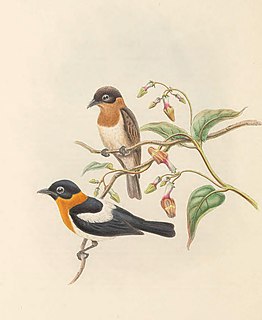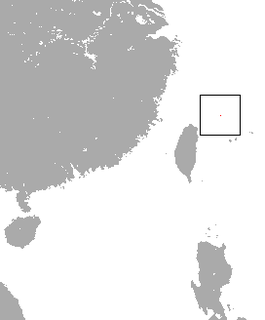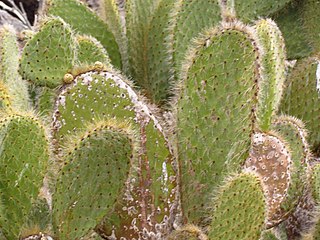
The pheasant pigeon is a species of large terrestrial pigeon. It is the only species of the monotypic genus Otidiphaps. The pheasant pigeon is found in the primary rainforests of New Guinea and nearby islands. It ranges primarily over hilly and lower mountain areas, but can also be found in lowlands.
Eupsophus insularis is a critically endangered species of frog in the family Alsodidae. It is endemic to Mocha Island in Chile, where found in temperate mixed forest. It is threatened by habitat loss.

The Madagascan flufftail is a species of bird in the family Sarothruridae. It is endemic to Madagascar.

The ochre-collared monarch or rufous-collared monarch is a species of bird in the family Monarchidae. It is found in Yapen and northern New Guinea. Its natural habitats are subtropical or tropical moist lowland forests and subtropical or tropical moist montane forests.
The San José Island kangaroo rat is a subspecies of rodent in the family Heteromyidae. It is endemic to Mexico, where it is found only on San José Island off the east coast of Baja California Sur. is restricted to an area of only 30 km2 in the southwestern coast of San José Island, Lower California, with the population having been drastically reduced in size and being close to extinction No other species of Dipodomys occur in sympatry with D. insularis.

The insular mole is a species of mammal in the family Talpidae. It is found in China and Taiwan, where it is also known as the Formosan blind mole. The species was first described by Robert Swinhoe in 1863.

The Senkaku mole, also known as the Ryukyu mole, is a species of mammal in the family Talpidae. It was formerly classified as being the only species in the genus Nesoscaptor. It is endemic to the Uotsuri-jima of the disputed territory of Senkaku Islands, also known as the Diaoyutai Islands. It is most similar to the Insular mole of Taiwan and Mainland China.

Pteropus pelagicus is a species of fruit bat in the family Pteropodidae. It includes two subspecies that were formerly recognized as full species— Pteropus insularis and Pteropus phaeocephalus. It is endemic to Micronesia. It is threatened by habitat loss.

The black jackrabbit is a species of mammal in the family Leporidae. Endemic to Mexico, its only known location is Espiritu Santo Island in the Gulf of California. The IUCN has listed this species as a "vulnerable species" because of its restricted range. This taxon is regarded by some authorities as being a subspecies of the black-tailed jackrabbit, found on the mainland of Mexico.
Macroperipatus insularis is a species of velvet worm in the Peripatidae family. It may be found in Jamaica, Hispaniola, or Haiti. The species is listed as Endangered on the IUCN Red List.
Micrarionta opuntia, known as the prickly pear island snail, pricklypear islandsnail, or prickly pear snail, is a species of land snail in the family Xanthonychidae. It is endemic to California, first formally described in 1975.
Helicia insularis is a species of plant in the family Proteaceae. It is endemic to Papua New Guinea. It is threatened by habitat loss.

Opuntia echios is a species of plant in the family Cactaceae. It is endemic to the Galápagos Islands (Ecuador) and is commonly known as the Galápagos prickly pear, but there are five other species of prickly pears that also are endemic to the archipelago.

Opuntia galapageia is a species of cactus. It is endemic to the Galápagos Islands, part of Ecuador. There are three varieties: Opuntia galapageia var. galapageia on Bartolome, Santiago, and Pinta, Opuntia galapageia var. macrocarpa on Pinzon and Opuntia galapageia var. profusa on Rabida.

Opuntia helleri is a species of plant in the family Cactaceae. This vulnerable species is endemic to the Galapagos Islands (Ecuador), where restricted to Wolf, Darwin, Marchena, and Genovesa.
Opuntia saxicola is a species of plant in the family Cactaceae. This critically endangered species is endemic to the Galapagos Islands (Ecuador), where it is restricted to the island of Isabela.
The Bismarck crow is a species of crow found in the Bismarck Archipelago. It was considered by many authorities to be a subspecies of the Torresian crow, but is now treated as a distinct species.

Cannaphila is a small Neotropical genus of dragonflies in the family Libellulidae. They are commonly called narrow-winged skimmers. One species, C. insularis, occurs in North America. There are three species.
The Cuban yellow bat is a species of bat from the family Vespertilioninae. It was previously included as a subspecies of the northern yellow bat, a species that has a similar ecology and biology. The species is endemic to Cuba, specifically the Las Villas Province in Cienfuegos, and it is listed under the IUCN Red List as vulnerable due to its ongoing population reduction and relatively small geographic range.
The Bahama nuthatch is a nuthatch endemic to the pine forests of Grand Bahama island in the Bahamas. It is usually considered a subspecies of the brown-headed nuthatch, although some authorities recognize it as a distinct species. It has some notable differences from its mainland counterpart, including a darker brown facial stripe, a longer bill, shorter wings, and a unique warbling call. Research using genetic markers indicates that both species likely diverged around 685,000 years ago.












